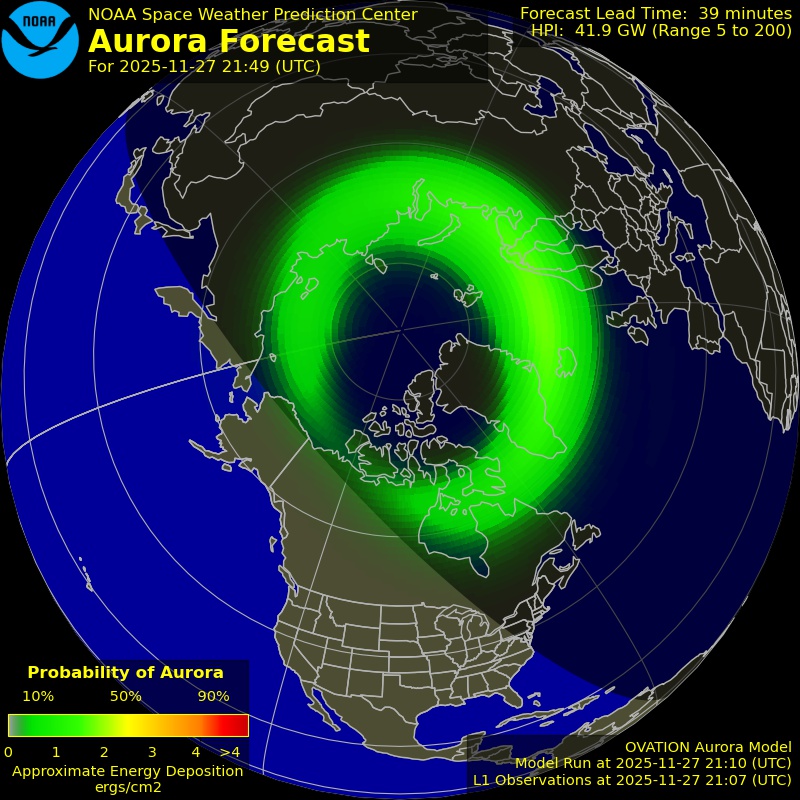Northern Lights Forecast for Saskatoon
Substorm
Substorm Phase: Quiet; Aurora Activity Score: 15/100
Ideal Conditions for Northern Lights in Saskatoon:
Power: +31 Gw | Bz: -2 | Wind Speed: 400+ | Density: 4+ | Kp: 3.5+
If the data above meets or exceeds the power meets then the aurora borealis should be visible within Saskatoon.
Embark on a journey to witness this celestial spectacle, where the vibrant energy of the city meets the captivating magic of the auroras. Our tool is your compass in this adventure, guiding you through the cosmic symphony that graces the skies above Saskatoon.
Introduction – How to use this data:
Unlock the magic of witnessing the mesmerizing Northern Lights in Saskatoon with our cutting-edge tool. Seamlessly predicting aurora appearances, we curate live satellite data into a user-friendly dashboard, eliminating the noise. While decoding the data might sound daunting, our comprehensive guide makes it a breeze.
Elevate your Aurora-chasing journey by embracing our extended forecast feature. Craft your adventure well in advance, soaking up the anticipation for the awe-inspiring Northern Lights show that can grace the Saskatoon skies. Plus, our real-time minute-to-minute insights ensure an immersive and personalized encounter you won't forget.
Where to see the northern lights in Saskatoon?
The enchanting dance of the Northern Lights in Saskatoon can be best witnessed away from the city's bright lights. Seek out locations with unobstructed views of the northern horizon, such as open fields or viewpoints along the Saskatchewan River.
Here are some of our favorite places:
- Wanuskewin Heritage Park: This cultural and natural site offers a serene environment outside the city lights, making it an ideal spot to catch the Northern Lights.
- Grasswood Observation Site: Located just south of Saskatoon, this spot provides an open view of the northern horizon, offering an excellent vantage point for aurora watching.
- Furdale Dog Park: With its expansive fields and minimal light pollution, Furdale Dog Park provides an optimal setting for observing the dazzling Northern Lights.
- Cranberry Flats Conservation Area: Situated along the South Saskatchewan River, this area offers a secluded location away from urban lights, enhancing your chances of witnessing the auroras.
- Nutana Rotary Park: While not entirely free from light pollution, this park within Saskatoon still offers relatively darker skies for aurora enthusiasts.
- Dundurn National Historic Site: A bit farther from Saskatoon, this historic site offers open spaces and clear views of the northern skies, increasing your chances of seeing the Northern Lights.
- Rural Areas Outside Saskatoon: Exploring the rural areas surrounding Saskatoon, especially to the north, provides even darker skies, enhancing the visibility of the captivating Northern Lights.
Remember to check aurora forecasts and solar activity levels for the best chances of witnessing this natural wonder in Saskatoon.
When can you see northern lights in Saskatoon?
Usually after dark around 11:00 PM to 3 AM the next morning. On very strong nights the northern lights have been able to be seen much earlier.
When is the best time of year to see the aurora borealis in Saskatoon?
The best time of year to see the aurora borealis in Saskatoon is during the fall and winter months, from September to April. These seasons offer longer nights and darker skies, providing optimal conditions for observing the mesmerizing Northern Lights. While the auroras can appear throughout the year, the increased darkness during the fall and winter months enhances your chances of witnessing this captivating natural phenomenon in Saskatoon.
Can you see the northern lights in Saskatoon tonight?
Whether you can see the Northern Lights in Saskatoon tonight depends on a variety of factors, including geomagnetic conditions and solar activity. For the most accurate updates, keep a close watch on Aurora Admin, our real-time aurora forecasting tool. Monitoring the incoming data on Aurora Admin will provide you with the best chance of experiencing the awe-inspiring Northern Lights illuminating the Saskatoon night sky.
How long do the Northern Lights usually last?
The duration of the Northern Lights, scientifically known as the aurora borealis, can vary. On average, a single display of the Northern Lights may last anywhere from a few minutes to several hours. However, during periods of heightened solar activity and favorable conditions, the auroras can persist for several hours, creating a captivating and enchanting spectacle in the night sky. The exact duration depends on factors such as the intensity of the solar storm, atmospheric conditions, and the strength of the aurora display. Keep in mind that while some auroras are brief, others can offer an extended and breathtaking show, providing a memorable experience for observers.
Aurora Oval
Northern Hemisphere

